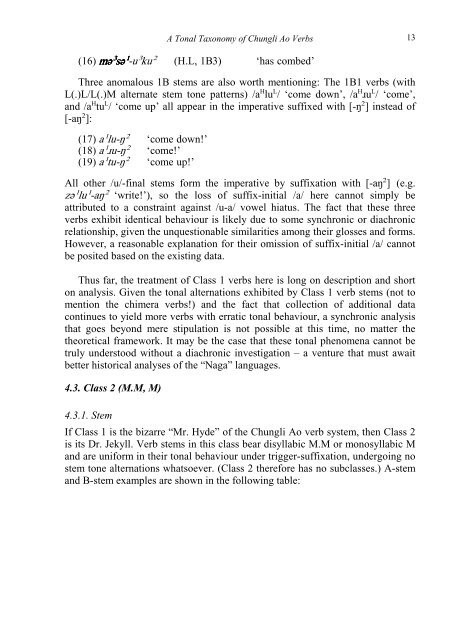A TONAL TAXONOMY OF CHUNGLI AO VERBS Daniel Bruhn ...
A TONAL TAXONOMY OF CHUNGLI AO VERBS Daniel Bruhn ...
A TONAL TAXONOMY OF CHUNGLI AO VERBS Daniel Bruhn ...
You also want an ePaper? Increase the reach of your titles
YUMPU automatically turns print PDFs into web optimized ePapers that Google loves.
A Tonal Taxonomy of Chungli Ao Verbs<br />
(16) mmmməəəə³³³³ssssəəəə¹¹¹¹-u³ku² (H.L, 1B3) ‘has combed’<br />
Three anomalous 1B stems are also worth mentioning: The 1B1 verbs (with<br />
L(.)L/L(.)M alternate stem tone patterns) /a H lu L / ‘come down’, /a H ɹu L / ‘come’,<br />
and /a H tu L / ‘come up’ all appear in the imperative suffixed with [-ŋ²] instead of<br />
[-aŋ²]:<br />
(17) a¹lu-ŋ² ‘come down!’<br />
(18) a¹ɹu-ŋ² ‘come!’<br />
(19) a¹tu-ŋ² ‘come up!’<br />
All other /u/-final stems form the imperative by suffixation with [-aŋ²] (e.g.<br />
zə¹lu¹-aŋ² ‘write!’), so the loss of suffix-initial /a/ here cannot simply be<br />
attributed to a constraint against /u-a/ vowel hiatus. The fact that these three<br />
verbs exhibit identical behaviour is likely due to some synchronic or diachronic<br />
relationship, given the unquestionable similarities among their glosses and forms.<br />
However, a reasonable explanation for their omission of suffix-initial /a/ cannot<br />
be posited based on the existing data.<br />
Thus far, the treatment of Class 1 verbs here is long on description and short<br />
on analysis. Given the tonal alternations exhibited by Class 1 verb stems (not to<br />
mention the chimera verbs!) and the fact that collection of additional data<br />
continues to yield more verbs with erratic tonal behaviour, a synchronic analysis<br />
that goes beyond mere stipulation is not possible at this time, no matter the<br />
theoretical framework. It may be the case that these tonal phenomena cannot be<br />
truly understood without a diachronic investigation – a venture that must await<br />
better historical analyses of the “Naga” languages.<br />
4.3. Class 2 (M.M, M)<br />
4.3.1. Stem<br />
If Class 1 is the bizarre “Mr. Hyde” of the Chungli Ao verb system, then Class 2<br />
is its Dr. Jekyll. Verb stems in this class bear disyllabic M.M or monosyllabic M<br />
and are uniform in their tonal behaviour under trigger-suffixation, undergoing no<br />
stem tone alternations whatsoever. (Class 2 therefore has no subclasses.) A-stem<br />
and B-stem examples are shown in the following table:<br />
13

















